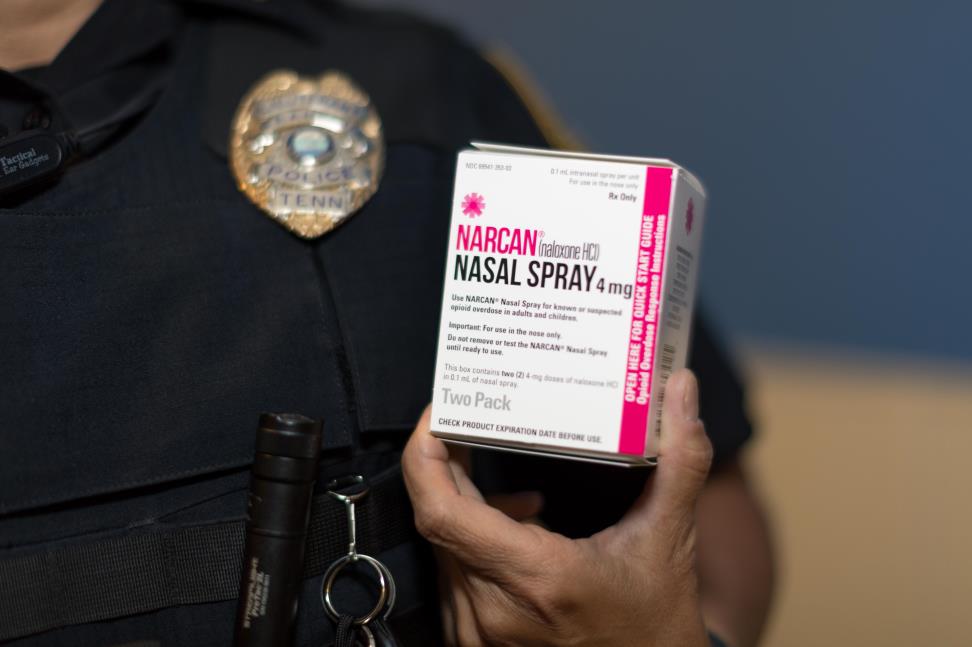Cops seem to have decided that ever since fentanyl came into the illicit drug supply, regular-strength Narcan is no longer enough. The standard 4 mg is still more than enough for reversing overdose, but the moment 4 mg Narcan stopped being enough for cops was probably when the Food and Drug Administration approved an 8 mg version.
Kloxxado, the opioid overdose antidote manufactured by Hikma Pharmaceuticals, was approved in May 2021. It’s a nasal spray exactly like Narcan—just double the dose. People who use opioids want it kept far away from them, but it’s been enthusiastically endorsed by law enforcement departments, in accordance with the profession’s misguided beliefs about how overdose works.
The first analysis of Kloxxado’s real-world use was conducted by the New York State Department of Health, New York State Police (NYSP) and Albany Medical College. They found no apparent benefits compared to Narcan—but some very apparent harms. The findings were published in a Centers for Disease Control and Prevention Morbidity and Mortality Weekly Report on February 8.
The analysis of NYSP overdose response data spanned March 2022, when three troops began using Kloxxado, to August 2023. The showed that whether the officers used 4 mg Narcan or 8 mg Kloxxado made no difference in survival rate. It also made no difference in how many doses were used. If cops decide naloxone isn’t working fast enough, they’ll use a second dose regardless of whether that brings someone to 8 mg or 16 mg.
The right dose of naloxone is the lowest one that restores normal breathing. The unnecessary dose is the one wakes them up.
Naloxone can be safely administered to anyone—babies; dogs—but it can have harms for people who use opioids, depending how it’s administered. The right dose of naloxone is the lowest one that restores normal breathing. The unnecessary dose is the one wakes them up.
If you give just enough to get someone breathing on their own again and then stop, they can peacefully sleep it off. If you keep giving them more, they go into precipitated withdrawal, a state torturous enough that it leaves people at immediate risk of overdosing again when they seek to relieve the symptoms. The dramatic, sitting bolt upright, huge gasp of air type of reversal doesn’t have to happen—cops just keep going until it does, as if it’s supposed to be the norm.
“No significant differences were observed in survival,” the authors stated in the report. “[H]owever, persons who received the 8-mg intranasal naloxone product had 2.51 times the risk for opioid withdrawal signs and symptoms, including vomiting, than did those who received the 4-mg.”
Despite what the CDC and the National Institute on Drug Abuse and the National Harm Reduction Coalition say from time to time, fentanyl doesn’t require more naloxone than less-potent opioids like heroin. Naloxone usually works after just the first dose, it just takes two or three minutes for that dose to kick in. If you’ve waited that long (give rescue breaths!) and don’t see someone breathing on their own, then it’s time for the next one.
The authors also note that previous research has also found no evidence supporting the belief that fentanyl is too strong for naloxone. It is simply a thing cops say because they heard other cops say it, and it sounds right. They’ll hit someone with one dose of Narcan, reach right over the little step-by-step instruction pamphlet to grab a second, and have pumped in three or five or eight doses by the time the first one’s had a chance to work. Then they’ll tell journalists how it takes so much more Narcan to bring someone back these days, so you know the fentanyl is getting stronger.
Naloxone works the same way on fentanyl as it does on heroin or hydrocodone.
Naloxone, whether it’s injected into the muscle or sprayed up the nose, doesn’t act on the opioids themselves. It acts on the brain’s mu receptors, and when it finds them it knocks off any opioids that happened to be sitting there first. All opioids, no matter their potency, occupy these same receptors, which is why naloxone works the same way on fentanyl as it does on heroin or hydrocodone.
Once the naloxone reaches about 50 percent of your mu receptors, overdose is reversed. You only have so many mu receptors, so extra doses don’t make the naloxone work faster or better.
Usually about 0.4 mg of naloxone will do it, which is why that’s is the amount contained in each vial of the generic intramuscular kind. Narcan contains a higher dose than that because a nasal spray doesn’t deliver naloxone as efficiently as an intramuscular shot. But at 10 times higher, the recipient is probably already getting more than they need, and nasal sprays aren’t a delivery system that can be titrated. If cops are starting people off with 8 mg of naloxone and then moving up by increments of the same, all it does it guarantee suffering.
“This initial study suggests no benefits to law enforcement administration of higher-dose naloxone,” the report concluded. Law enforcement will suggest them anyway.
Correction, February 21: This article has been updated to reflect that the CDC was not affiliated with the research, and to correctly identify the police department. It is NYSP, not NYPD.
Photograph via City of Franklin, Tennessee




